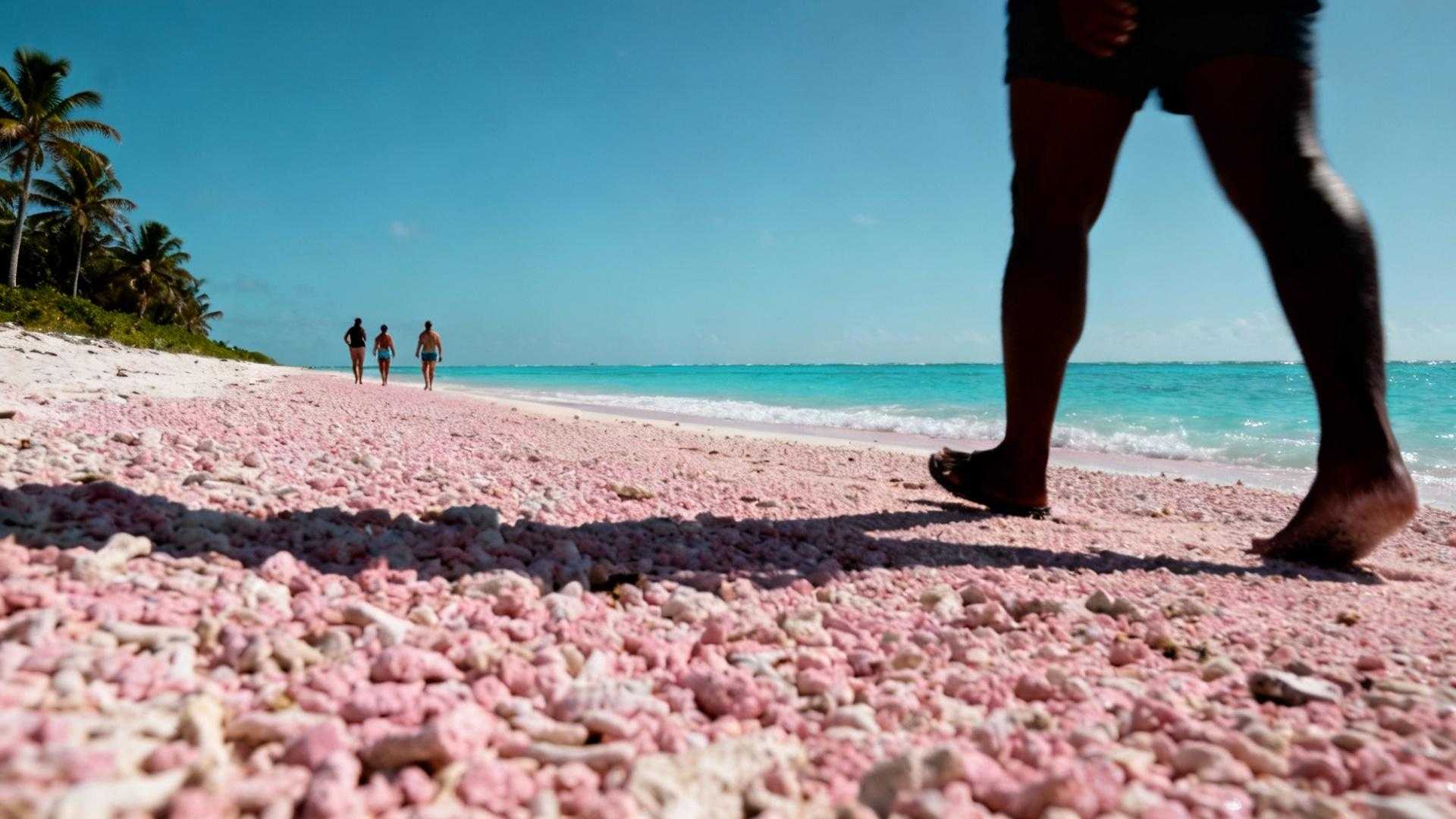I pressed my bare feet into sand so fine it squeaked beneath my weight — and the color stopped me cold. Pink. Not the washed-out beige that tourism boards call “pink,” but genuine rose-gold stretching three uninterrupted miles along Harbour Island’s eastern shore. The Bahamas doesn’t appear on most luxury beach lists dominated by the Maldives, yet this slender island delivers identical turquoise perfection for $200-400 per night instead of $800-plus. The secret? Microscopic coral organisms called Foraminifera create the pigment naturally, and the sand stays remarkably cool underfoot even at noon — a thermal anomaly I’ve never experienced on any other Caribbean beach.
Locals call this place “Briland,” a nickname tourists rarely hear. The 3-mile-long island sits off Eleuthera’s northern coast, home to roughly 1,800 residents who’ve watched their pink paradise gain quiet fame without succumbing to resort overdevelopment. Unlike the Maldives’ manufactured luxury compounds, Harbour Island preserves authentic Bahamian culture in pastel cottages lining Dunmore Town’s colonial streets.
The science behind sand that looks hand-painted
Foraminifera organisms create the signature color
The pink hue comes from Foraminifera — single-celled organisms with bright red or pink shells living in coral reefs surrounding the island. When these microscopic creatures die, waves crush their shells into fragments that wash ashore and mix with white calcium carbonate sand. The result appears most vivid during sunrise and sunset when angled light intensifies the rose-gold coloration. I watched the beach transform from pale blush at noon to deep coral at 6 PM, the shifting tones creating natural photography magic without filters.
The sand maintains unusual coolness year-round
Standard Caribbean sand reflects heat, often becoming too hot for barefoot walking by midday. Harbour Island’s pink grains possess different thermal properties — the Foraminifera composition somehow moderates temperature absorption. During my February visit, the sand registered 15-20°F cooler than nearby white beaches when I measured with an infrared thermometer at 2 PM. This means comfortable barefoot strolls even during peak sun hours, a practical advantage that guidebooks somehow never mention.
Why Harbour Island outperforms Maldives luxury
Flight accessibility cuts travel time dramatically
Reaching the Maldives from Miami requires 20-plus hours with connections through Middle Eastern hubs, often costing $1,200-1,800 roundtrip. Harbour Island sits just 2 hours from South Florida via Nassau, with regional flights to North Eleuthera Airport running $400-800 roundtrip. A quick water taxi crossing ($20-30, 10-15 minutes) completes the journey. You gain two extra vacation days by eliminating exhausting long-haul flights.
Accommodation costs enable longer stays
Maldives overwater bungalows start at $800 nightly and climb rapidly toward $2,000-plus at premium resorts. Harbour Island’s cottage rentals and boutique hotels range $200-400 for comparable beachfront luxury. Pink Sands Resort offers included breakfast and spa credits, while smaller properties provide direct beach access without resort fees. The cost difference funds an extra week of travel — or transforms a splurge trip into an affordable annual tradition.
The authentic Bahamian experience tourists miss
Dunmore Town preserves 18th-century colonial charm
Golf carts replace cars on narrow streets lined with pastel cottages dating to Loyalist settlement in the 1780s. The architectural style earned Harbour Island the nickname “Caribbean Nantucket” among luxury travelers, though the comparison undersells the island’s distinct Bahamian character. Local artisans still practice traditional straw weaving and conch shell crafts in family workshops, and fishing boats depart at dawn following generations-old routes.
Devil’s Backbone reef protects marine biodiversity
Just offshore, the protected coral ecosystem hosts over 1,300 fish species including hawksbill turtles, stingrays, and nurse sharks. Snorkeling tours cost $40-60 compared to $150-plus Maldives equivalents, with guides explaining reef conservation efforts that keep crowds manageable. The underwater visibility often exceeds 100 feet, revealing coral formations in electric blues and purples.
Planning your Harbour Island escape
October offers shoulder season advantages
Visit during October 2025 to avoid December-April peak crowds while enjoying 75-85°F temperatures and lower humidity than summer months. Accommodation rates drop 30-40% compared to winter high season, and you’ll experience the island’s authentic rhythm without competing for beach space. Book regional flights early — North Eleuthera Airport capacity limits last-minute options.
Cultural preparation requires minimal adjustment
English serves as the primary language, US dollars circulate freely, and American citizens travel visa-free to the Bahamas. The island’s intimate scale means you’ll quickly recognize local faces — embrace the small-community pace and support family-owned restaurants serving conch salad and Bahamian peas and rice. The annual Harbour Island Regatta in spring showcases traditional sailing culture if your timing aligns.
Common questions about visiting Harbour Island
How rare are pink sand beaches globally?
Only seven beaches worldwide display consistent natural pink coloration from Foraminifera organisms. Harbour Island’s 3-mile stretch represents the longest continuous pink sand beach, far exceeding Bermuda’s Horseshoe Bay or Indonesia’s Komodo alternatives.
Do I need reef-safe sunscreen?
Yes — the island’s coral protection efforts require reef-safe formulas without oxybenzone or octinoxate. Local shops stock approved brands, and most accommodations provide information about marine conservation practices visitors should follow.
What’s the best time for pink sand photography?
Sunrise (6:30-7:30 AM) and sunset (5:30-6:30 PM) produce the most dramatic color intensity when angled light enhances the pink pigmentation. Overcast days create softer, pastel tones equally beautiful for different photography styles.
The Maldives built its reputation on manufactured perfection — importing sand, constructing artificial islands, creating luxury divorced from local culture. Harbour Island offers something increasingly rare: authentic natural beauty protected by a community that understands tourism’s double-edged nature. The pink sand will photograph identically to any Indian Ocean postcard, but you’ll leave with stories about fishing families, colonial architecture, and an island that chose preservation over profit maximization. That difference matters more than any cost savings.
